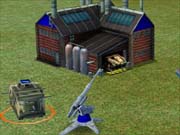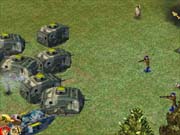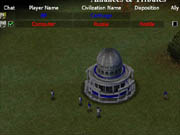Empire Earth Updated Preview
New impressions and images detail our new preview of this epic RTS that spans all of human history.

Real-time strategy games seem to flow from an inexhaustible fount that publishers dip into on a whim. With such a crowded field, any new RTS game needs to go the extra mile (or more) to stand out among its peers. If you were to take just a fleeting glance at Stainless Steel Studios' forthcoming Empire Earth, you might shrug it off as another Age of Empires clone with little new to offer. After all, Ensemble Studio's Age of Empires series is one of the landmarks of RTS gaming, with legions of fans and reams of critical plaudits to its credit, not to mention its share of copycats. Assuming that Empire Earth was one of those copycats would be an ironic assessment since Stainless Steel Studios and its maiden title are headed by none other than Rick Goodman, who was the cocreator/lead designer of the original Age of Empires. Instead of working on its hit sequel, Age of Empires II: The Age of Kings, Goodman struck out on his own in 1998 to found a new studio with one basic yet daunting goal in mind: to "become the industry's premier developer in real-time strategy games." Based on the latest beta build of Empire Earth, it looks like Goodman and company are heading down the right path.
One of the most obvious distinguishing traits of Empire Earth is its massive scope. With gameplay stretching from the Paleolithic era to two hundred years in the future, it covers a whopping 500,000 years of human history, dwarfing the scope of Age of Empires--and most games for that matter. In that regard, it calls to mind expansive games like Civilization more quickly than most RTS's. Empire Earth is divided into 14 epochs: Prehistoric, Stone, Copper, Bronze, Dark, Medieval, Renaissance, Imperial, Industrial, Atomic-World War I, Atomic-World War II, Atomic-Modern, Digital, and Nano.

You'll be able to play single, epic games through all the epochs or select individual ones. One of the great advantages to the game's huge time span is that it should ideally appeal to players with different interests. If you love science fiction RTS's, the Nano Age should offer plenty of entertainment in its own right. If you prefer more historically grounded action, the earlier ages should offer what you're looking for. Ideally, the ability to pick and choose ages should be like getting a number of RTS's in one package.
It's not merely what's in Empire Earth that should set it apart, but who's behind it. Despite all the QA that publishers send games through, a lot of them clearly could use more detailed input from hard-core gamers before heading to the store shelves. Stainless Steel Studios has made special efforts to corral top RTS players for their team to help ensure Empire Earth's appeal. Designer Richard Bishop, for example, cowrote the official strategy guide for Age of Empires. A number of other top Age of Empires players, some of them money-winning pros, have been enlisted to help balance the game.
A History of Conflict

Warfare is a way of life in Empire Earth. While you'll build and control great empires, the focus will largely center on armed conflict since the game is a very traditional RTS in many regards. That's not to say, though, that you'll spend all your time blasting enemy units off the map. You'll use workers to gather resources like gold, stone, and wood, and you'll erect different buildings like barracks, tank factories, and temples. These efforts, though, are geared toward building up your military might, as opposed to reaching great cultural heights.
You can choose from 21 different civilizations, such as the ancient Kingdom of Israel, the Ottoman Empire, or China, each with its unique bonuses, like increased cavalry speed or added hit points for buildings. If the provided civilizations don't whet your appetite for conquest, you'll be able to essentially design your own by tweaking about 100 different civilization attributes. Interestingly, in multiplayer games, you don't know what civilization your opponent has chosen until the game starts, urging you to develop strategies on the fly.

Like the time scale and number of civilizations you can control, the number of units in Empire Earth is impressively large. You'll likely get to wield around three hundred land, air, and sea units. While combat works on a rock-paper-scissors model and doesn't strive for wargame-like realism, its foundation in history means that you'll be familiar with most of the units. You'll control German Heinkel He 111 bombers from World War II and the United States' contemporary F-117A Stealth Fighter. On land, you'll employ everything from Assyrian guard dogs to the advanced Leopard main battle tanks used by today's German army. Greek triremes, with their three banks of oars, will ply the waves early in the game, while the USS Enterprise nuclear-powered aircraft carrier will dominate the seas later on. Selecting one unit of a particular type opens a menu that lets you pay for increased attack power, speed, range, and so on for all units of that type. You can also acquire special historical hero units, like Oliver Cromwell or Patton. While they're expensive to create, they confer important morale benefits on nearby troops.
Commanding units should be a breeze: Just right-click on objects, using a contextual cursor. In fact, the whole interface seems quite streamlined. All vital data and options, like resource totals and units available for creation in a selected building, are lined along the bottom of the screen. There's no need to scan the whole screen to find what you're looking for. Figuring out which button does what shouldn't present much of a problem, thanks to colorful icons with rollover help text. Some specific commands should also facilitate gameplay. For instance, an auto-explore button sends a unit out to reconnoiter on its own, which should be a most welcome alternative to the usual technique of setting up countless waypoints for scouts. Waypoints are of course still available, as are rally points and other standard RTS control options.
The Face of War

One of the most immediately striking things about Empire Earth is its visuals. The time and effort used to create the game's proprietary graphics engine seem to have been well spent. Environments and units are displayed in 3D, though they can only be viewed from a fixed angle. Camera movement is limited to panning and zooming, and the latter can conveniently be accomplished with the mouse wheel. Ideally, this setup should provide the best of both 3D and 2D isometric gaming, letting you stay abreast of the action easily while still enjoying detailed visuals.
Impressive visual detail, in fact, looks to be one of Empire Earth's hallmarks, and you'll notice it right from the striking, cinematic intro movie, with scenes of broadside naval battles and German Panzers rumbling through North Africa during World War II. During any given epoch, you'll notice an array of clever, artistic touches that bring the buildings, units, and terrain to life. Trees gently sway in the breeze, ocean tides lap against the shoreline, and indigenous creatures like eagles and ostriches soar or trot by. While some of the units, particularly individual human characters as opposed to planes or ships, tend to look blocky when you've zoomed all the way in, they're still colorful. More importantly, they're very expressive. "Idle animations" have your overworked villagers wiping the sweat off their brow, for instance. Guard dogs will stretch in a remarkably convincing manner, and soldiers handle their weapons believably.

The game's rousing musical score should also grab your attention right away. Some excellent sound effects really build the mood too. The booming reports of a galleon's cannons are particularly striking, and less obvious effects, like a berry bush rustling as a peasant plucks its fruit, add to the ambience. While the sounds are impressive at this stage, the voice-overs still need work. As it stands, no matter which civilization you choose, your units respond in English, and often rather dully. Hopefully these are just placeholders to be replaced with the appropriate languages for more color.
As it stands, Empire Earth doesn't look like it will be a monumental step forward for the RTS genre, and while it might not be a pure Age of Empires clone, it certainly shares much with those games. On the other hand, it clearly should have lots to offer if its obvious breadth can be matched by equal depth. At this stage, it seems pretty clear that the game will have fine graphics and sound. Multiple single-player campaigns, customizable multiplayer modes, and a full campaign/scenario/map editor should ensure replayability. Empire Earth will also have the distinct advantage of arriving well before the game many might consider its main competition: Ensemble Studio's Age of Mythology. One of the challenges facing Empire Earth will be ensuring that unglamorous periods like the Prehistoric or Copper epochs will offer enough interest to compete with the "sexier" units of the later ages. If that and some other issues can be addressed, Empire Earth should prove to be worth the multiyear wait.
Got a news tip or want to contact us directly? Email news@gamespot.com
Join the conversation